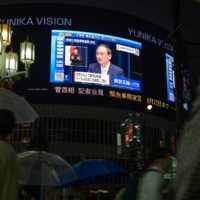Japan has yet to use about ¥20 trillion ($180 billion) out of some ¥73 trillion under its three fiscal 2020 extra budgets to fund stimulus packages in the fight against the coronavirus pandemic, a Kyodo News tally showed Tuesday.
The finding based on data released by the Cabinet Office in May reflects the government’s slow response in efforts to mitigate the economic fallout from the pandemic as well as stalled projects such as a domestic tourism promotion campaign due to further spread of the virus.
The amount of leftover funds was revealed as Prime Minister Yoshihide Suga’s Liberal Democratic Party is considering drawing up another large-scale supplementary budget to finance fresh economic stimulus, apparently looking to win public support ahead of a general election that must be held by November.
The government earmarked over ¥3.6 trillion as financial aid for restaurants and bars that comply with local authorities’ requests to shut down or cut operating hours to curb the virus spread, but just about ¥970 billion of the budget had been provided as of late April, according to the tally.
Delays in clerical work are believed to lie behind the amount yet to be used.
Of about ¥2.37 trillion set aside for the state-subsidized Go To Travel campaign, launched in July last year to boost the virus-hit domestic tourism sector, only ¥940 billion has been delivered to tourists and service operators due to its nationwide suspension since late December in response to a spike in virus cases.
The Cabinet Office has examined the budget implementation status covering projects for which more than ¥10 billion in state funds has been allocated, with financial support for small and midsize firms excluded from the review.
Some of the leftover funds will be spent in fiscal 2021, which started in April, or later.
In a time of both misinformation and too much information, quality journalism is more crucial than ever.
By subscribing, you can help us get the story right.
SUBSCRIBE NOW



